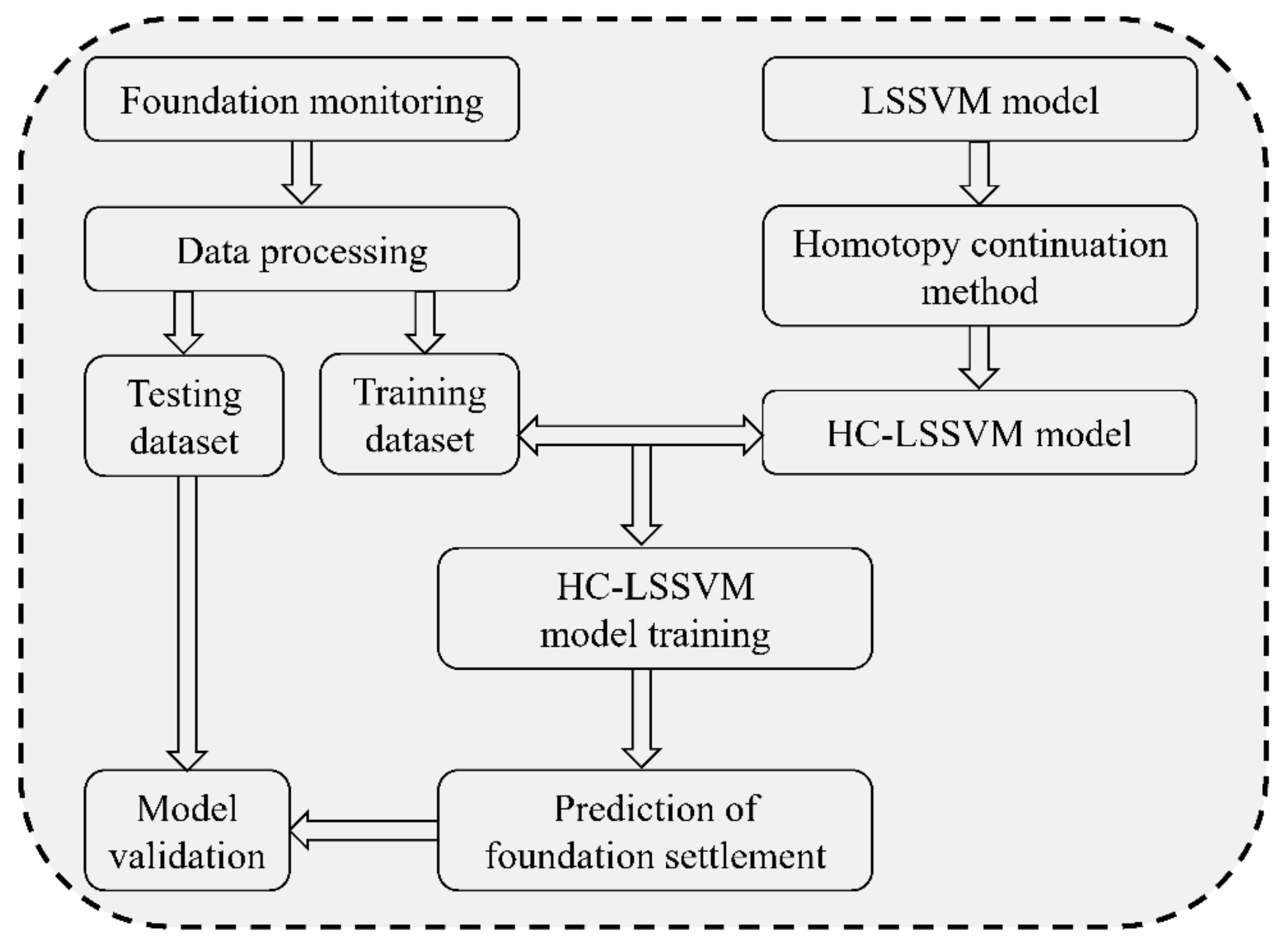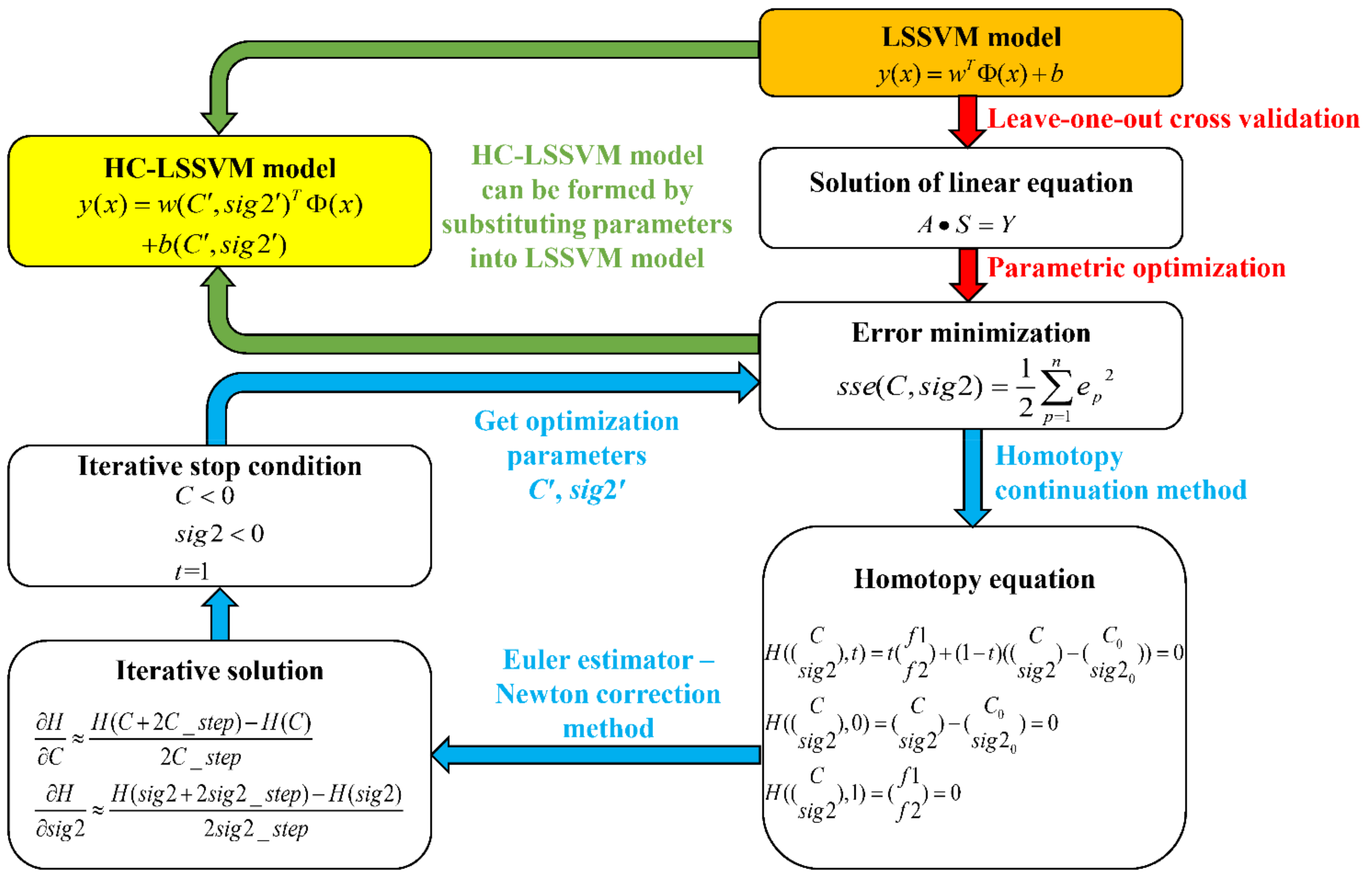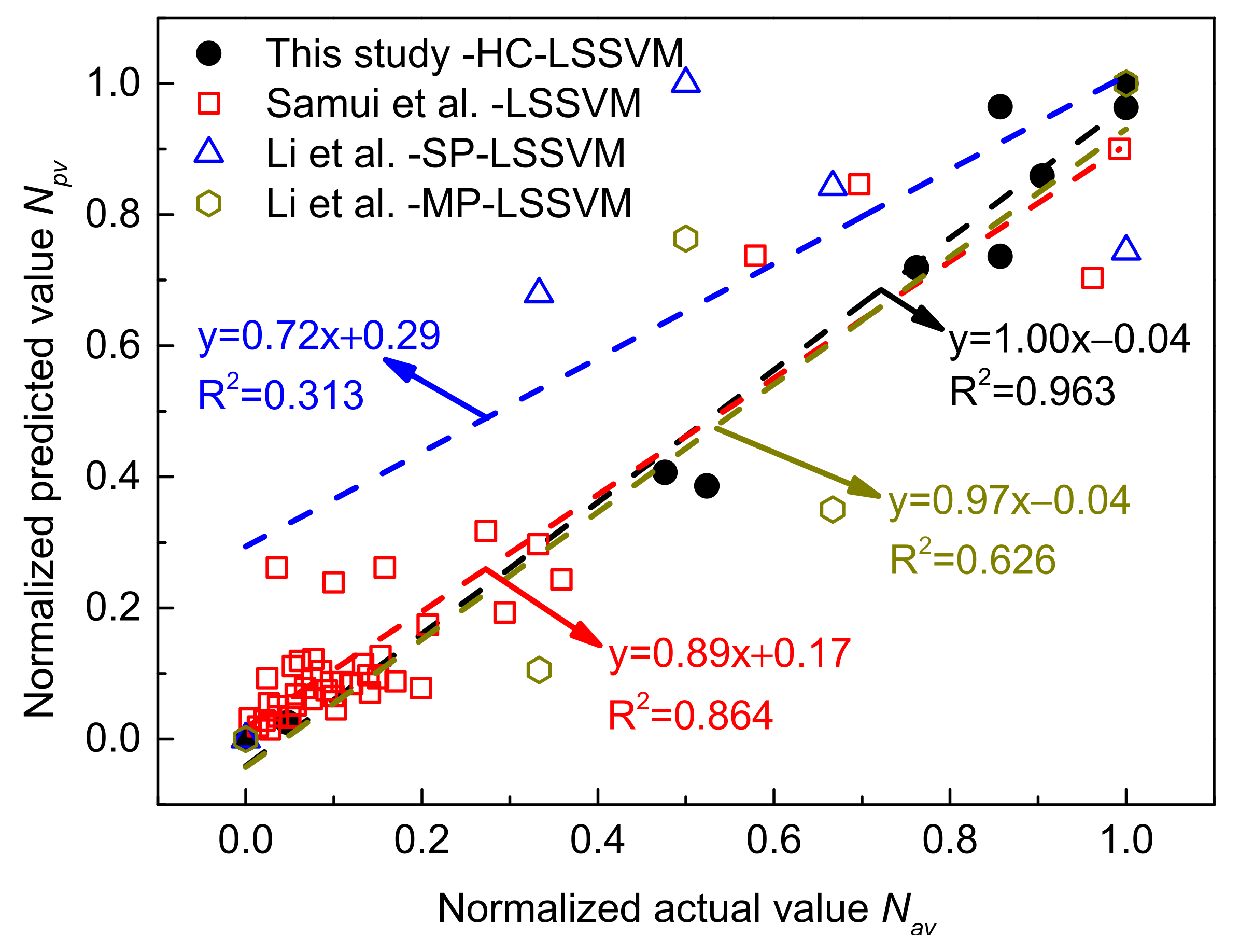Research on HC-LSSVM Model for Soft Soil Settlement Prediction Based on Homotopy Continuation Method
Abstract
:1. Introduction
2. Methods
2.1. LSSVM Model for Soft Ground Settlement Prediction
2.2. LSSVM Model Parameter Solution Based on Homotopy Continuation Method
- (1)
- Establish training sample set and test sample set based on soft soil settlement observation data.
- (2)
- Construct the homotopy equation:where C0 and sig20 are the initial LSSVM model parameters. When t = 1, the obtained solutions of are the optimal LSSVM model parameters.Suppose the known solution of is . In order to find the solution curve = of the homotopy equation, take the derivative of parameter t, then the solution problem of nonlinear equations is transformed into the initial value problem of differential equations,
- (3)
- The grid search method was used to select the LSSVM model parameters: the initial regularization parameter C0 and the kernel parameter sig20. The grid search range of LSSVM parameters was given and the corresponding grid search step was set. Set the grid search stop conditions, including stop the search when the maximum search times are met, stop the search when t = 1 is met when the first homotopy path is found, and stop the search when the LSSVM model parameters exceed the grid search range.
- (4)
- Set the initial value t = 0 of the homotopy parameter t, and set the homotopy parameter step t_step.
- (5)
- Set the iteration stop condition of the Euler forecaster-Newton correction method [23,24], and repeatedly use Euler forecaster-Newton correction method to solve Equation (15) until the iteration stop condition is satisfied.First, the next approximate point of the homotopy path is obtained by euler estimation method,Then, Newton’s correction method is used to correct the approximate points,In order to simplify the calculation of partial derivatives and , the following equation is adopted in this study to simplify the calculation of partial derivatives,where C_step and sig2_step are step sizes. Therefore, proper C_step and sig2_step must be selected before solving the equations with Euler estimation-Newton correction method. Iteration stop conditions include iteration stops when C < 0 and sig2 < 0; iteration stops when t = 1. Optimization parameters C′ and sig2′ were obtained after iteration.
- (6)
- If the first homotopy path ending condition t = 1 is not found, the initialization LSSVM model parameters and the grid search step are modified. If the homotopy path end condition is t = 1, then the LSSVM model parameters are the LSSVM model parameters optimized by homotopy continuation method.
- (7)
- The HC-LSSVM regression model was established by using the LSSVM model parameters optimized by homotopic continuation method, and the settlement of the test sample set was predicted, and the corresponding prediction results were finally output.
2.3. HC-LSSVM Model for Prediction of Soft Soil Settlement
3. Results and Discussion
3.1. Soft Soil Settlement
3.2. Training and Testing of the HC-LSSVM Model
3.3. Evaluation of the HC-LSSVM Model
4. Conclusions
- (1)
- On the basis of the leave-one-out cross-validation method, the homotopy continuation method was used to optimize the LSSVM model parameters with the goal of minimizing the sum of squares of the prediction errors of the full sample retention one, and then the HC-LSSVM model was constructed, which solved the problems of low search efficiency in the search process and lack of global optimal solution in the search results of the existing LSSVM models.
- (2)
- Comparing with training samples and test samples, the HC-LSSVM model can accurately predict soft soil settlement, and the prediction result is significantly better than that of ordinary LSSVM model.
- (3)
- The research results provide a new method for the prediction of soft soil settlement. The prediction of future settlement amount based on the existing observation data can effectively prevent the occurrence of disasters.
Author Contributions
Funding
Institutional Review Board Statement
Informed Consent Statement
Data Availability Statement
Acknowledgments
Conflicts of Interest
Abbreviations
| xi | Input vector |
| Rm | Input space |
| yi | Output vector |
| Rn | Output space |
| n | Number of training samples |
| Φ | Kernel space mapping function |
| H | Feature space |
| w | Weight vector in space H |
| b | Offset parameter |
| C | Tunable regularization parameter |
| ek | Error variables |
| αi | Lagrange multiplier |
| S(p) | The p th element in S |
| S(p−) | Column vector of S minus the p th element |
| A−1(p,p) | Element in row p and column p of A−1 |
| A−1(p−,p) | Column vector of the column p of A−1 minus the p th element |
| σ2 | Kernel function parameter, labeled sig2 |
| K(xk, xl) | Dot product kernel function |
| K′(p,p−) | Row vector of the row p of K′ minus the p th element |
| t_step | Homotopy parameter step size |
| C_step | Regularized parameter step size |
| sig2_step | Kernel function parameter step size |
| f | Mapping of input space to output space |
| C′ | Tunable regularization parameter of homotopy continuation method |
| sig2′ | Kernel function parameter of homotopy continuation method |
| Xn | Normalized predicted or monitored value |
| Xr | Predicted or monitored values before the normalization |
| Xmax | Maximum predicted or monitored value before the normalization |
| Xmin | Minimum predicted or monitored value before the normalization |
| L | Thickness of soft soil |
| e | Void ratio |
| n | Poisson’s ratio |
| Cv | Consolidation coefficient |
| wn | Natural moisture content |
| wL | Liquid limit |
| k | Permeability coefficient |
| OCR | Over-consolidation ratio |
| Cc | Compression index |
| Cr | Rebound index |
| E | Young’s modulus of elasticity |
| qu | Unconfined compressive strength |
| h | Groundwater level |
| Cst | Cumulative settlement time |
| Csa | Cumulative settlement amount |
| Av | Actual value of cumulative settlement amount |
| Pv | Predicted value of cumulative settlement amount |
| εa | average error |
| ε | Error |
| Npv | Normalized predicted value |
| Nav | Normalized actual value |
References
- Zhou, S.; Wang, B.; Shan, Y. Review of research on high-speed railway subgrade settlement in soft soil area. Railw. Eng. Sci. 2020, 28, 129–145. [Google Scholar] [CrossRef]
- Achmus, M.; Thieken, K. On the behavior of piles in non-cohesive soil under combined horizontal and vertical loading. Acta Geotech. 2010, 5, 199–210. [Google Scholar] [CrossRef]
- Conte, E.; Pugliese, L.; Troncone, A.; Vena, M. A Simple Approach for Evaluating the Bearing Capacity of Piles Subjected to Inclined Loads. Int. J. Geomech. 2021, 21, 04021224. [Google Scholar] [CrossRef]
- Pan, F.W. Observation and Evaluation of Subgrade’s Settlement. Adv. Mater. Res. Switz. 2012, 368–373, 2075–2078. [Google Scholar] [CrossRef]
- Wei, J.H.; Song, Z.Z.; Bai, Y.X.; Liu, J.; Kanungo, D.P.; Sun, S.R. Field Test and Numerical Simulation for Coordinated Deformation of New Subgrade and Old Embankment Adjacent to River. Appl. Sci. 2018, 8, 2334. [Google Scholar] [CrossRef] [Green Version]
- Zhai, H.B.; Ding, H.Y.; Zhang, P.Y.; Le, C.H. Model Tests of Soil Reinforcement Inside the Bucket Foundation with Vacuum Electroosmosis Method. Appl. Sci. 2019, 9, 3778. [Google Scholar] [CrossRef] [Green Version]
- Wei, H.Y.; Liang, G.Q.; Zhang, C.J. Analysis of Monitoring and Settlement Prediction of Wenzhou Shoal Seawall. In Advances in Civil and Industrial Engineering IV; Trans Tech Publications: Stafa-Zurich, Switzerland, 2014; Volume 580, pp. 1993–1999. [Google Scholar] [CrossRef]
- Luo, J.H.; Wu, C.; Liu, X.L.; Mi, D.C.; Zeng, F.Q.; Zeng, Y.J. Prediction of soft soil foundation settlement in Guangxi granite area based on fuzzy neural network model. In IOP Conference Series: Earth and Environmental Science; IOP Publishing: Bristol, UK, 2018; Volume 108, p. 032034. [Google Scholar] [CrossRef]
- Zhu, M.C.; Li, S.Q.; Wei, X.L.; Wang, P. Prediction and Stability Assessment of Soft Foundation Settlement of the Fishbone-Shaped Dike Near the Estuary of the Yangtze River Using Machine Learning Methods. Sustainability 2021, 13, 3744. [Google Scholar] [CrossRef]
- Ray, R.; Kumar, D.; Samui, P.; Roy, L.B.; Goh, A.T.C.; Zhang, W.G. Application of soft computing techniques for shallow foundation reliability in geotechnical engineering. Geosci. Front. 2021, 12, 375–383. [Google Scholar] [CrossRef]
- Bi, G.Q. Prediction of ground settlement based on immune genetic algorithm. In Applied Mechanics and Materials; Trans Tech Publications Ltd.: Bäch, Switzerland, 2012; Volume 155, pp. 1056–1060. [Google Scholar] [CrossRef]
- Wang, H.Q.; Sun, F.C.; Cai, Y.N.; Ding, L.G.; Chen, N. An unbiased LSSVM model for classification and regression. Soft Comput. 2010, 14, 171–180. [Google Scholar] [CrossRef]
- Mohanty, R.; Das, S.K. Settlement of Shallow Foundations on Cohesionless Soils Based on SPT Value Using Multi-Objective Feature Selection. Geotech. Geol. Eng. 2018, 36, 3499–3509. [Google Scholar] [CrossRef]
- Li, X.; Liu, X.; Li, C.Z.; Hu, Z.M.; Shen, G.Q.; Huang, Z.Y. Foundation pit displacement monitoring and prediction using least squares support vector machines based on multi-point measurement. Struct. Health Monit. 2019, 18, 715–724. [Google Scholar] [CrossRef]
- Zhang, L.M.; Wu, X.G.; Ji, W.Y.; AbouRizk, S.M. Intelligent Approach to Estimation of Tunnel-Induced Ground Settlement Using Wavelet Packet and Support Vector Machines. J. Comput. Civ. Eng. 2017, 31, 04016053. [Google Scholar] [CrossRef]
- Kumar, M.; Samui, P. Reliability Analysis of Settlement of Pile Group in Clay Using LSSVM, GMDH, GPR. Geotech. Geol. Eng. 2020, 38, 6717–6730. [Google Scholar] [CrossRef]
- Samui, P.; Sitharam, T.G. Least-square support vector machine applied to settlement of shallow foundations on cohesionless soils. Int. J. Numer. Anal. Methods Geomech. 2008, 32, 2033–2043. [Google Scholar] [CrossRef]
- Kundu, S.; Khare, D.; Mondal, A. Individual and combined impacts of future climate and land use changes on the water balance. Ecol. Eng. 2017, 105, 42–57. [Google Scholar] [CrossRef]
- Chapelle, O.; Vapnik, V.; Bousquet, O.; Mukherjee, S. Choosing Multiple Parameters for Support Vector Machines. Mach. Learn. 2002, 46, 131–159. [Google Scholar] [CrossRef]
- Gunji, T.; Kim, S.; Kojima, M.; Takeda, A.; Fujisawa, K.; Mizutani, T. PHoM—A Polyhedral Homotopy Continuation Method for Polynomial Systems. Computing 2004, 73, 57–77. [Google Scholar] [CrossRef]
- Lin, Q.; Xiao, L. An adaptive accelerated proximal gradient method and its homotopy continuation for sparse optimization. Comput. Optim. Appl. 2015, 60, 633–674. [Google Scholar] [CrossRef] [Green Version]
- van Gestel, T.; Suykens, J.A.K.; Baesens, B.; Viaene, S.; Vanthienen, J.; Dedene, G.; de Moor, B.; Vandewalle, J. Benchmarking Least Squares Support Vector Machine Classifiers. Mach. Learn. 2004, 54, 5–32. [Google Scholar] [CrossRef]
- Shirazy, A.; Shirazi, A.; Nazerian, H.; Khayer, K.; Hezarkhani, A. Geophysical Study: Estimation of Deposit Depth Using Gravimetric Data and Euler Method (Jalalabad Iron Mine, Kerman Province of IRAN). Sci. Res. 2021, 11, 340–355. [Google Scholar]
- Jaffe, A.; Weiss, R.; Nadler, B. Newton correction methods for computing real eigenpairs of symmetric tensors. SIAM J. Matrix Anal. Appl. 2017, 39, 1071–1094. [Google Scholar] [CrossRef] [PubMed] [Green Version]
- Wang, S. Research on the Design of Swelling Soil Subgrade of Lian-Xu Experssway; Master Southeast University: Nanjing, China, 2000. [Google Scholar]
- Feng, W. Application of MATLAB-ANN System in Expressway Soft Ground Settlement Prediction. Master’ Thesis, Chang’an University, Xi’an, China, 2005. [Google Scholar]
- GB 50021-2001. Code for Investigation of Geotechnical Engineering; Ministry of Construction: Bejing, China, 2009; pp. 140–144.
- Wang, X.; Yuan, H. Design and Construction Technology of Embankment on Soft Soil Foundation of High-Grade Highway; People’s Communications Press: Beijing, China, 2001. [Google Scholar]





| Cumulative Settlement Time Cst (Day) | Cumulative Settlement Amount Csa (mm) | Cumulative Settlement Time Cst (Day) | Cumulative Settlement Amount Csa (mm) | Cumulative Settlement Time Cst (Day) | Cumulative Settlement Amount Csa (mm) |
|---|---|---|---|---|---|
| 0 | 0 | 246 | 134 | 525 | 158 |
| 29 | 8 | 254 | 134 | 555 | 163 |
| 31 | 11 | 277 | 134 | 556 | 163 |
| 46 | 41 | 308 | 134 | 586 | 176 |
| 60 | 69 | 321 | 134 | 587 | 176 |
| 63 | 70 | 339 | 134 | 618 | 187 |
| 91 | 90 | 370 | 140 | 619 | 188 |
| 93 | 90 | 388 | 141 | 648 | 197 |
| 122 | 90 | 401 | 144 | 649 | 198 |
| 124 | 97 | 422 | 143 | 679 | 203 |
| 153 | 109 | 432 | 144 | 680 | 205 |
| 155 | 110 | 456 | 144 | 711 | 205 |
| 184 | 122 | 463 | 144 | 712 | 206 |
| 187 | 122 | 489 | 152 | 741 | 208 |
| 215 | 126 | 494 | 153 | 742 | 208 |
| 220 | 127 | 523 | 158 |
| Cumulative Settlement Time Cst (Day) | Avalue of Cumulative Settlement Amount Av (mm) | Predicted Value of Cumulative Settlement Amount Pv (mm) | Error ε (%) |
|---|---|---|---|
| 618 | 187 | 180.41 | 3.52 |
| 619 | 188 | 181.20 | 3.62 |
| 648 | 197 | 193.02 | 2.02 |
| 649 | 198 | 192.38 | 2.83 |
| 679 | 203 | 202.69 | 0.15 |
| 680 | 205 | 203.23 | 0.86 |
| 711 | 205 | 210.31 | 2.52 |
| 712 | 206 | 207.04 | 0.50 |
| 741 | 208 | 210.28 | 1.08 |
| 742 | 208 | 211.41 | 1.61 |
Publisher’s Note: MDPI stays neutral with regard to jurisdictional claims in published maps and institutional affiliations. |
© 2021 by the authors. Licensee MDPI, Basel, Switzerland. This article is an open access article distributed under the terms and conditions of the Creative Commons Attribution (CC BY) license (https://creativecommons.org/licenses/by/4.0/).
Share and Cite
Cui, G.; Xiong, S.; Zhou, C.; Liu, Z. Research on HC-LSSVM Model for Soft Soil Settlement Prediction Based on Homotopy Continuation Method. Appl. Sci. 2021, 11, 10666. https://doi.org/10.3390/app112210666
Cui G, Xiong S, Zhou C, Liu Z. Research on HC-LSSVM Model for Soft Soil Settlement Prediction Based on Homotopy Continuation Method. Applied Sciences. 2021; 11(22):10666. https://doi.org/10.3390/app112210666
Chicago/Turabian StyleCui, Guangjun, Shenghua Xiong, Cuiying Zhou, and Zhen Liu. 2021. "Research on HC-LSSVM Model for Soft Soil Settlement Prediction Based on Homotopy Continuation Method" Applied Sciences 11, no. 22: 10666. https://doi.org/10.3390/app112210666
APA StyleCui, G., Xiong, S., Zhou, C., & Liu, Z. (2021). Research on HC-LSSVM Model for Soft Soil Settlement Prediction Based on Homotopy Continuation Method. Applied Sciences, 11(22), 10666. https://doi.org/10.3390/app112210666






